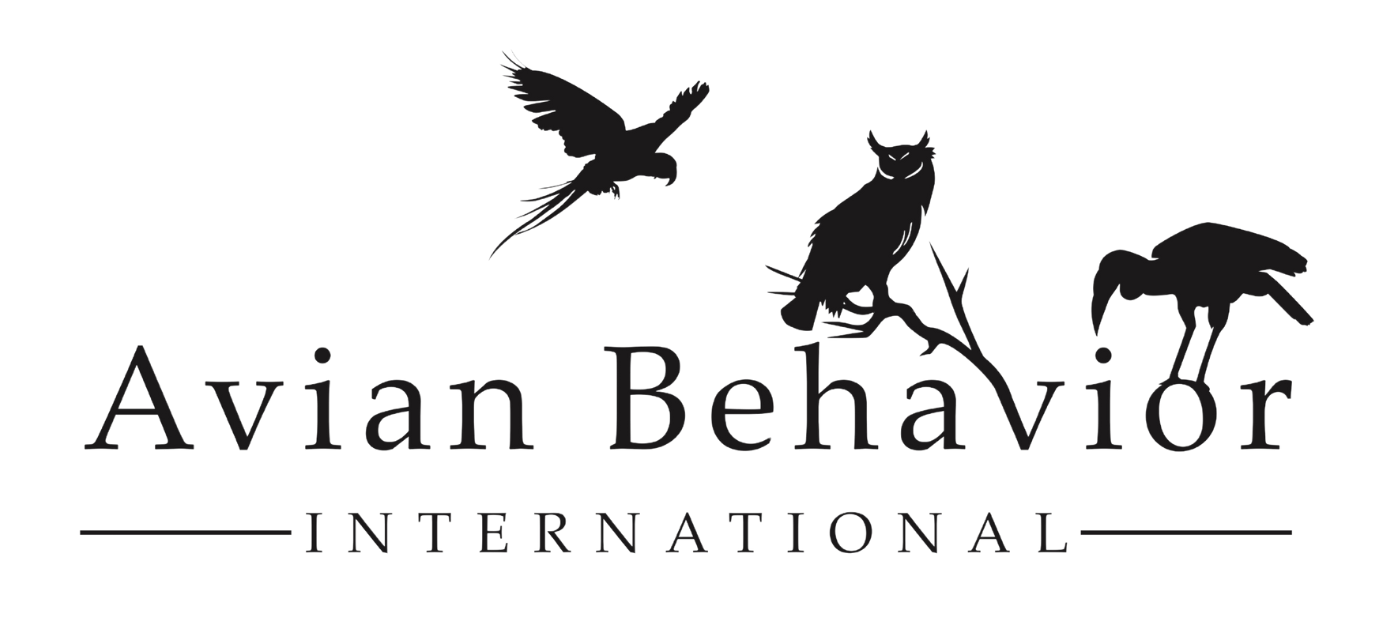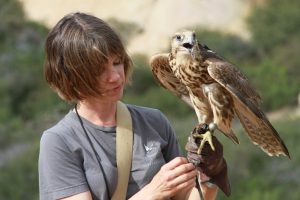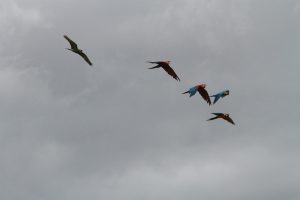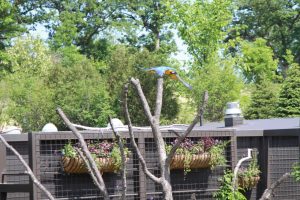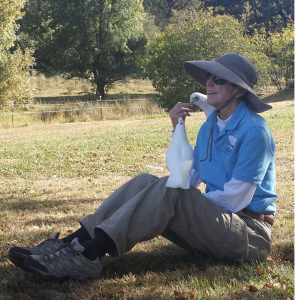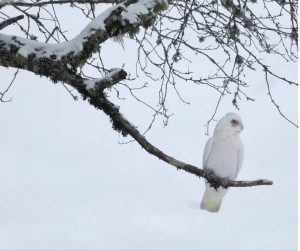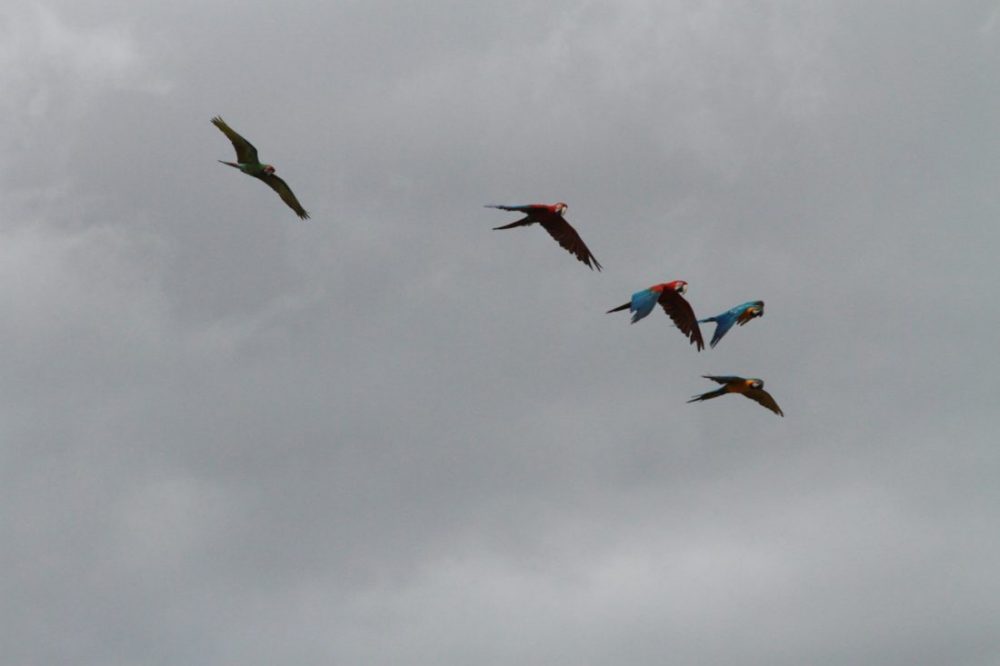
05 Jul Part II: Ruminations on Free Flying Parrots and Thoughts for Long Lasting Success
I wrote an article about the many risks facing companion parrot owners that were considering training their birds for free flight in 2014, and my conclusion was essentially “Please don’t.” The stipulation to that is that in-person guided mentorship is a critical component that is most likely to bring about long-term success. I recognize that the preaching of abstinence is not always the best strategy, but I am not comfortable promoting an activity that has proven to put the lives of animals directly into the face of danger without a substantial mitigation of risk on the part of the human by way of a thorough undertaking of research and enhancement of training skills.
This article is meant to answer as many of the questions I still get from parrot owners and trainers who have seen losses and struggled to work with their parrots past various challenges, to help discuss a few topics that aren’t readily torn open with companion parrot free flight based on my unique experience. I thought I would put a few of my thoughts together in a cohesive essay to talk about a few of things I think are important for long term success.
While I feel that my work having flown birds since 2001 is significant, there is always more to learn. I have the added bonus of having my falconry license, and through training my raptors to hunt and the many incredible falconry mentors that has brought me, these along with my work with a wide variety of species have supplemented my understanding of flight training tremendously. I feel that, along with other trainers who have maintained a relative degree of long term success, analyzing training with an eye for operant conditioning as well as the natural history of the species’ behavior is vitally important lifelong endeavor.
One idea that sets the falconry community apart from the amateur parrot free flying community is that falconry by its very nature expects and assumes that risks inherent in keeping and thus free flying one’s bird. Falconry, having been practiced for 4000 years, comes with it the comradery and understanding of this extreme responsibility. That is not to say that falconers don’t offer each other unsolicited (and at times, unnecessarily rude) advice, but the underlying understanding in falconry is that the bird is meant to be flown and there are far too many variables to expect safety in every outcome. We mitigate what we can and give the bird the best tools to be successful.
The parrot owning community comes from a place where, not too long ago, the norm held that clipping wings was considered to be an absolute must in order to keep a bird safe. There is considerable blowback when parrot owner loses a bird as we wrestle with the concept of guardianship as the idea of free flight continues to grow and mature. While there are supporters often to help someone search for their bird, hang lost posters, and organize boots on the ground efforts to find the wayward parrot, there is enough back and forth mudslinging to make anyone think twice before putting word out on social media looking for help when one of their free flying parrots goes missing.
And yet, as we attempt to drown out each other’s voices in an effort to decide what is best for our birds, something more insidious happens to the parrots trained to fly free and the trainers who are considering it. We are failing them epically when we protect our pride a bit too preciously and judge each other a bit too harshly. In silencing each other from talking about these losses and fly offs or feeling embarrassed, grief stricken, or just simply dumbfounded, we are failing to collect empirical data about what could have caused the fly off and how the data can help others. The inability to break down why a flight session went wrong is a critical inadequacy and something we must work to correct.
Fly offs happen. Fly offs happen to professional bird trainers in zoos and to amateurs, and they happen regardless of what species the bird is. They are very much a part of free flying birds due to our inability to control all of the variables. Sometimes
the bird is retrieved because the protocols worked perfectly to plan, and sometimes the bird is retrieved based on a stroke of luck. And then there are times when the odds are completely against you and your bird, and you never see the bird again. These concepts hold true whether the free flight trainer is aware of how to mitigate risk or not, and therefore it is a challenge to convey the acceptance of risk to non-free flying parrot owners.
But let’s put a pin in that for a minute. What makes our birds fly off in the first place? Here are some examples of birds I know of that have been lost or killed. It is not all-inclusive, but to give the reader an idea of the types of losses prevalent in professional and amateur training programs.
- Predatory bird flies in, parrot is killed/flies out of sight
- Gets spooked by something, flies out of sight
- Bad weather comes, too wet to come down/too cold/flies out of sight
- Doesn’t want to come out of tree, stays out overnight, flies out of sight/gets killed
- Is worked in a new location, flies out of sight
- Flies out of sight, gets stolen
- Wants to make a nest with another parrot, flies out of sight
- Flies into moving car
- Flies into a lion enclosure
- Flies into a river
- Gets run off by ravens, flies out of sight
- Gets run off by passerines, flies out of sight
- Gets killed by dogs
- Gets zapped by electrocution
- Is shot by neighbor
Losses happen with a variety of different causes, and it’s my belief that not all losses are due to trainer error (or inexperience) nor can we chalk everything up to an unavoidable risk. It is our duty through thorough and sustained skill development to keep our flying parrots safe to the best of our ability. It is not an activity for everyone or every bird. Any loss is devastating, and a loss due to free flight will turn your world inside out. If it doesn’t, you’re doing it wrong
How would you categorize the above? I can think of three basic, broadly worded with often overlapping variables at play for most of the fly-off’s I know about:
- Fear
- Bad Timing
- Training oversight
So what, rather, makes a successful free flying parrot? If we look to the wild, parrots don’t have too many predators. Most of their predators are aerial or nocturnal. The flock helps, and parrots tend to fly together for the most part in small groups or pairs, and they tend to stick to a home territory.
Flying Your Parrot in New Places
When we take our parrots and fly them in new places around new birds, we are putting them on high alert and in a state of stress. In unfamiliar territory, they don’t know what predators are there, and thus how they will be hunting. Are they soaring predators, sneak attack predators, diving predators, mobbing or flocking predators, or mammalian predators? This is something that we may not necessarily think of instinctively but is very much something a prey species keeps in the foremost of its thoughts.
The parrots haven’t had a chance to map the area yet. Some birds, such as our falconry birds of prey, are more migratory by nature and flying in new places is part of their natural history. For a parrot, learning a new space takes a bit more time for them to be comfortable in it, and we can create other ways of giving them a sense of home, whether it’s a conspicuous landmark or call back birds, helps mimic the natural history element that would increase the probability of success.
Flocking Your Free Flying Parrots
Flock flying is another component that has always been a hugely important part of my parrots’ success. Raptors are virtually everywhere, and some areas may be more challenging than others. San Diego county is not unique in its raptor abundance. That said, while not all raptors are a danger to the parrots, there are non-raptor birds that are, such as ravens, crows, and even non-corvid passerines such as flycatchers, which are a species that are really protective of their nests and have led to losses for some parrot free flyers.
Flocking is something to put a lot of thought into when it comes to having and training free flying parrots. Some species of
parrot can add into their flock with no problems at all. Some parrots are challenging and can even kill one another when there is an odd parrot out. While I’m a big fan of flock flying, I used to get together with a friend and fly our birds together regularly, I have since seen some issues in the casual get-togethers with parrots flying with unfamiliar or vaguely familiar parrots. Whether or not it actually increases the chance of a fly off or not, I think the data is still out, but for those who do it, it is worthy of discussion. The flock dynamic is the essence of survival for a parrot in the wild, and it is something that needs to be viewed with care in free flying companion parrots.
My macaws and cockatoos have been chased by red tailed hawks, coopers hawks, and peregrine falcons, but they will react differently, depending on the situation. During a sustained effort of a peregrine falcon, say, they will actually bunch up together and work to get the invader away. It’s incredibly cool to watch the coordinated defensive effort by the flock of parrots as they enact their own version of “no bird left behind” and eventually the falcon gives up. Were it not for the collective set of eyes in the sky, they would have easily been surprised by the falcon in the first place.
There was another scenario when the macaws were nearing the end of their early stages of free flight training that a pair of nesting ravens chased my hyacinth and greenwing macaw duo, Luca and Leo, off one spring. They disappeared for three hours, over a stand of trees and out of sight so quickly I didn’t even have time to see in which precise direction they went. I searched in vain for a little while, returned to the ranch to regroup and organize a plan. Before I had time to set out again, the macaw pair had decided to chance the corvid gauntlet and came roaring back home, calling out one hundred feet overhead as they made a first pass over the aviaries, still unsure of how to overcome their adrenaline. It was just a year under their flight training, and they still had much to learn. After a few passes, they finally lowered themselves back down on to their aviaries.
The Dangers of Outsourcing Free Flight Training
Naturally, the bigger the parrot, generally the longer it takes to achieve a set of polished flight skills. Parrots are altricial by nature and require a heavy investment of parental resource to grow, build skills, learn to fly, and find food. Flight is incredibly risky to learn. The commercial endeavor of teaching and training other people’s parrots for free flight, whoever does it, must take into account the length of time that it takes for the parrot to feel truly confident in the air as well as the length of time it
takes for a trainer to develop an understanding of crucial training concepts. I approach this business endeavor with extreme reservation, not that people can’t effectively train their birds to the level of relative success that I have enjoyed, because the birds are the winners in that scenario. But by definition to build that business means pulling in an ever-increasing audience, and where the line between success and failure exists on a razor’s edge even just in taking care of an animal in a four-walled enclosure in the list of daily decisions we make; free flight is a tremendous responsibility to take on. And, by looking for hacks around the challenging early training process of a free flying parrot, we avoid the potential for exposing some critical gaps in training knowledge and comprehension, rehearsal of skill and mechanics, and understanding of the variety of risks that both human and bird will face. In creating a culture of out-sourcing this important stage, we are instead building a tremendous bubble of free flight perceived know-how that will indeed lead to more unnecessary losses and fly offs.
Training Free Flight to Older Parrots
And finally, I have three last parting thoughts to reiterate from the first article that I have been asked about in the years since. I absolutely and unequivocally cannot condone the training of older parrots to free fly. The program of free flight training is hard enough. Having a parrot outside is dangerous, as well. There are parrots that have been grabbed by red tailed hawks right off of people’s shoulders. Parrots that were not given the start from fledging to fly and be comfortable outdoors in an aviary without the security of a ceiling overhead will always be at an extreme disadvantage. They will fly differently than a bird that always has known flight and thus, in a way that attracts the eye of a predator. They will have a much longer learning curve in an activity that is extraordinarily unforgiving, even when all of the protocols are followed. There have been free flight trained parrots trained that were older when they got their start, but to let the exception prove the rule is to allow pride to endanger the lives of our birds. There have been too many heartbreaks for this practice to be considered acceptable. Older birds can have their lives enriched in a host of other ways.
Free Flight and Weight Management in Parrots
Secondly, I have said before and I will state again: I do not think it is necessary to weight manage parrots for free flight. Weight management is the reduction of a bird’s weight to increase motivation for training. Some trainer’s will reduce a bird 5% or up to 20%, to the point where a parrot cannot molt its feathers while in flying condition. I have reduced a parrot’s diet for a couple of meals before its initial free flight if it finds itself overcome with the adrenaline of a first big flight and needs increased motivation to work past the fear, or if we are going to try a new place. But rarely if ever do I reduce more than three meals, and I simply provide leaner meals for a very short stretch of time. By using the framework of the above described protocols, I have never seen the need to put parrots on a long-term diet modification plan for any reason other than health. I have, however, born witness to significant psychological and physiological damage to parrots under long term weight management programs that I do not wish for any animal. My conclusion after seeing these types of flight programs has been that if a parrot needs to be weight managed in such a way, then perhaps something is fundamentally wrong with the training program.
Relying on the Parental Bond for Free Flight
And finally, also worth stating again is that I have not seen any recognizable difference between training an unweaned parrot using one’s “parental bond” and training a young, fully fledged and fully weaned bird. I have trained both and have both in my current set of flyers. If anything, I would much rather see that fully weaned birds are going to homes, as nestlings and fledglings can see lasting impressions of fear when they experience significant changes during certain developmental stages, as well as creating a various health issues. Similarly, while citizen “science” would have us believe that the parental bond ends as soon as a parrot is eating on its own, the bond to a parrot’s family unit is strong for quite some time post weaning before true
dispersal. There is no magical window of opportunity to capitalize on this bond while a bird is still on formula and even more importantly, flying a parrot outdoors for long term success relies on training skills first, both for maintenance and in times of challenge. Relying on a bond does not instill the parrot with skills to overcome the many challenges and variables it will face, and most importantly, as my good friend and fellow trainer Chris Shank of Cockatoo Downs notes, it does not motivate the parrot keeper to learn the necessary training skills needed for long term success.
The free flight community, like any, strengthens in its ability to govern itself, ward off charlatans, and help those that are heading down a dangerous path. There are so many videos out there that belie the level of effort that goes into free flight training. On the other side of the coin, there are other videos that (unfortunately) show birds being launched in the air that don’t explain all of the training and management tools employed in order to create a somewhat unrealistic view of what the uneducated viewer aspires to achieve. Such is the way of our virally inclined society, but the argument remains that we can as free flight trainers and parrot keepers can support one another in talking about training: Be open with our losses, stresses, successes, and failures, just as we would in other training communities.
Free flight is not a new idea and there are protocols that we can look to that will help us achieve success and understand why losses occurred and what can be done about them. We can challenge each other to make good choices, ask questions when we are unsure, and support the evolution of companion animal keeping to promote the best possible life to all of those in our care.
Many thanks to Chris Shank of Cockatoo Downs and Kathryne Thorpe for their input and editing of this article.
